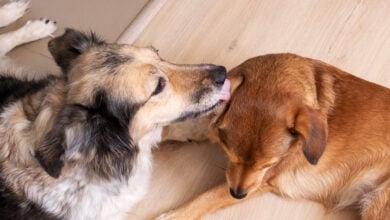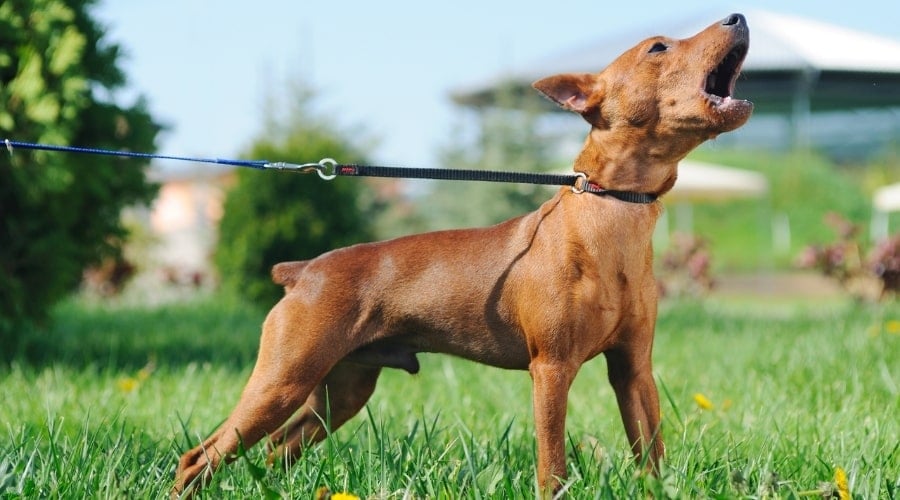Is Your Dog Seeing Things You Can’t at Night? Human vs. Canine Night Vision
When you purchase through links on our site, we may earn a commission. Here’s how it works.
Many of us have no choice but to walk our dogs in the dark, whether it’s a late-night potty break or an early morning stroll before the sun wakes up. As you fumble with the leash and try not to trip over the sidewalk, your dog trots ahead with zero hesitation. It almost seems like they can see better than you. But can dogs see in the dark? Or are they just winging it with their other senses?
Table of Contents
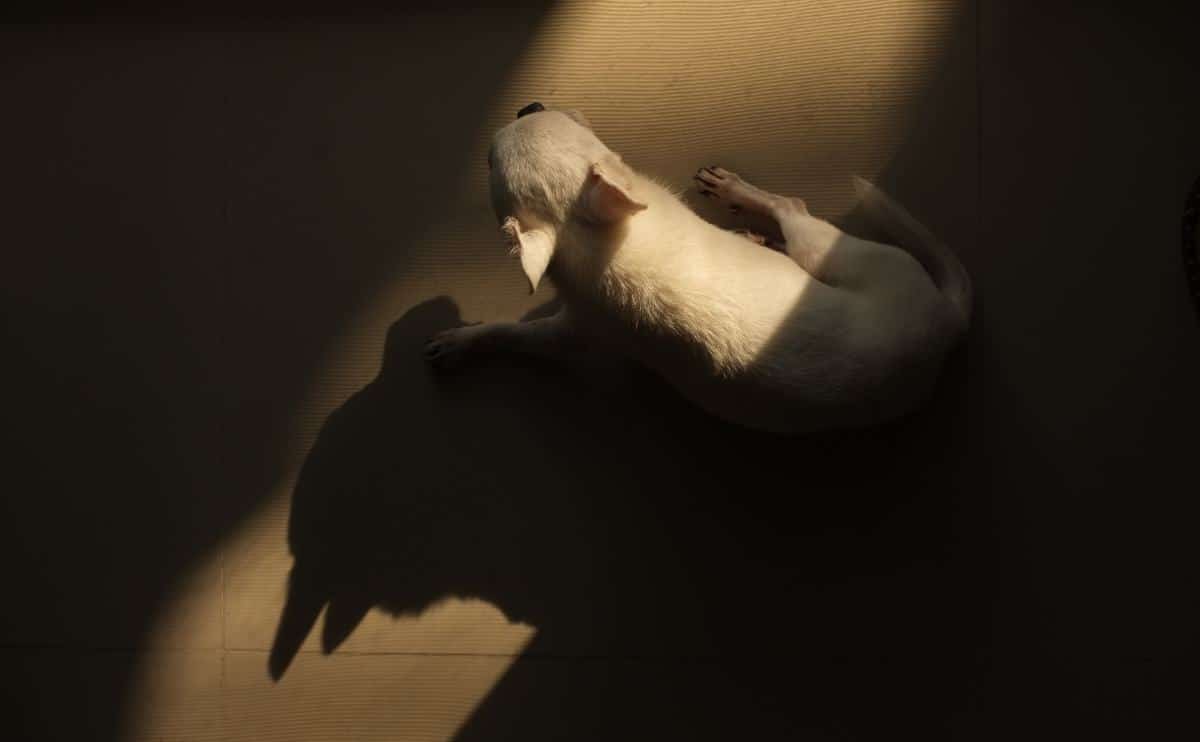
Dogs have a reputation for sharp senses, but how well can they actually see when the lights go out? Are they navigating with super-powered night vision, or are they just better at faking confidence in the dark than we are? We dug into the science to find out how their vision stacks up against ours and, of course, how they compare to the ultimate nighttime prowlers: cats.
Can Dogs See in the Dark? The Truth About Their Night Vision
Can dogs see in the dark? Do they have some kind of superior night vision? Not exactly. While your dog might trot confidently ahead on a nighttime walk while you fumble with your phone’s flashlight, they don’t have true night vision like military-grade goggles. They can’t see in complete darkness, but they do have a major advantage in low-light conditions.
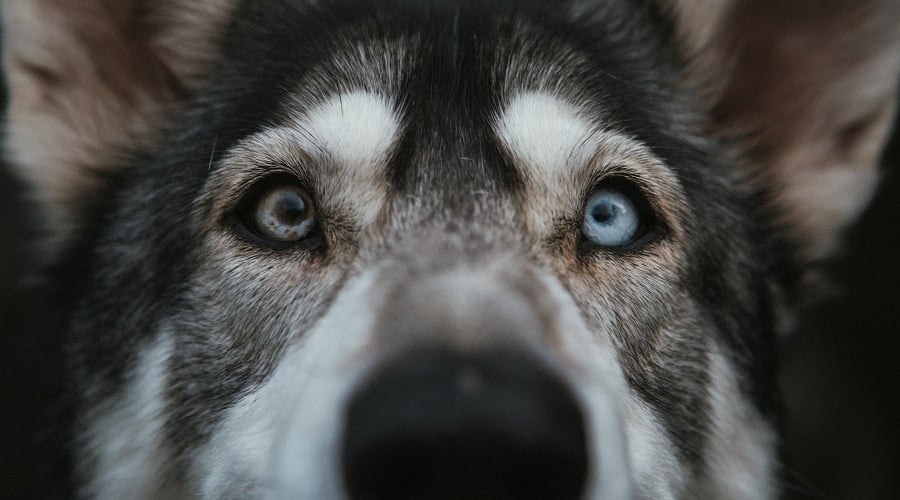
Dogs have evolved to navigate in dim lighting, which helps them see better than us when the sun goes down. But if you were hoping they had superhero-level night vision, think again. They rely on other senses, like their powerful noses, to fill in the gaps when visibility gets tricky.
Dogs vs. Humans: Who Wins the Battle of Night Vision?
Your pup has a serious edge over you when it comes to seeing in the dark. According to the Merck Veterinary Manual, dogs detect motion and light shifts much better than humans. That means they can spot a squirrel darting across the yard long before you can.
However, dogs struggle with visual sharpness. If you have 20/20 vision, you can see details much clearer than your pup, who has around 20/75 vision. This means that what you see clearly at 75 feet, they’d need to be about 20 feet away to make out. Think of their vision as slightly blurry compared to ours. The video below gives an idea of what we see and what our dogs see to better illustrate the difference in our eyes.
How Did Dogs Develop Their Night Vision? A Look at Evolution
Dogs haven’t always been the couch-loving, treat-demanding companions we know today. Their ancestors were wild canines that relied on hunting, scavenging, and navigating in low-light environments to survive. Scientists believe that early canines were crepuscular hunters, meaning they were most active during dawn and dusk—a time when prey was also on the move.
In these dim conditions, sharp vision wasn’t just helpful. It was critical for survival. Canines that could detect movement in low light had a better chance of hunting successfully and avoiding predators. Over time, natural selection favored those with better low-light vision, leading to the night-adapted eyes that modern dogs have today.
However, as dogs became domesticated and started relying on humans for food and safety, their need for exceptional night vision diminished. Unlike their wild ancestors, most modern dog breeds don’t need to rely solely on eyesight to hunt or escape danger. As a result, dogs today have a balance between day and night vision rather than being fully nocturnal like some other animals.
How Do Dogs See Better in Low Light?
So, if dogs can’t see fine details or a full spectrum of colors, why do they dominate in the dark? It all comes down to some fascinating adaptations in their eyes.

Scientists believe early canines were most active at dawn and dusk, much like deer, rabbits, and other crepuscular animals. Over time, their eyes evolved to perform better in these conditions, even as domesticated dogs became accustomed to brighter light. Three key anatomical differences help dogs see better when the sun goes down:
- More retinal rods – Dogs have a higher number of rod cells in their retinas. Rods are light-sensitive cells that detect movement and help with night vision. More rods mean dogs can see better in dim lighting than humans.
- Reflective membranes (tapetum lucidum) – Have you ever noticed your dog’s eyes glowing at night? That’s thanks to the tapetum lucidum, a reflective layer behind the retina that bounces light back through the eye, essentially amplifying what little light is available. Humans don’t have this feature, which is why we’re left stumbling in the dark.
- Larger pupils – A dog’s pupils are much bigger than ours, which means they can take in more light. This helps improve their vision in low-light settings, even if their world isn’t as sharp as ours.
The Science Behind the Tapetum Lucidum: A Built-In Light Booster
One of the biggest reasons dogs see better than humans in dim light is the tapetum lucidum, a mirror-like layer of tissue located behind the retina. When light enters a dog’s eye, it passes through the retina, where rod cells (light-sensitive receptors) detect it. But instead of absorbing all the light as human eyes do, the tapetum lucidum reflects it back through the retina, giving their photoreceptors a second chance to pick up more visual information.
This is why your dog’s eyes glow in the dark when light hits them at night. That eerie reflection is the tapetum bouncing light back through their eyes, effectively amplifying what little light is available and improving their ability to see in darkness.
How Does the Tapetum Affect What Dogs See?
While the tapetum lucidum helps dogs see better in low light, it comes at a cost. It slightly blurs their vision. Since light is bouncing around and getting reflected back, the image a dog sees isn’t as crisp as what a human would perceive in bright daylight. Think of it as taking a photo in low light without a flash. The details are there, but they’re a little fuzzy.
Why Do Some Dogs Lack a Tapetum Lucidum?
Interestingly, not all dogs have this special light-reflecting layer. Some breeds, particularly those with blue eyes, can be born without a tapetum lucidum or have a weaker version.
Why? Scientists aren’t entirely sure. However, here’s what they do know:
Breeds with light-colored or blue eyes (like Siberian Huskies, Australian Shepherds, and some Labrador Retrievers) are likelier to lack a functional tapetum lucidum.
In some cases, genetics may play a role. Certain bloodlines of Labrador Retrievers and Beagles carry genes that lead to an absent or non-reflective tapetum. Dogs that lack a tapetum may struggle more in the dark than their tapetum-equipped counterparts. This could explain why some blue-eyed dogs hesitate more in low-light environments or rely more on their sense of smell.
Since the tapetum lucidum is designed to help with low-light vision, dogs without one may need extra lighting indoors at night to navigate comfortably. If your pup seems to struggle in dim rooms or avoids dark hallways, a small nightlight near their sleeping area could make a big difference.
Is Your Senior Dog Struggling to See? The Truth About Aging Eyes
Watching your dog grow older is bittersweet. The once boundless energy slows down, the muzzle turns gray, and you start noticing small changes. These can be simple, like hesitation on the stairs or a missed treat toss that once would have been caught mid-air. Vision loss is a natural part of aging for many dogs, and while they may not go completely blind, their world becomes a little less sharp and a little harder to navigate.

Just like in humans, aging affects the eyes’ ability to process light, movement, and detail. The lenses in a dog’s eyes become less flexible, making it harder for them to focus. Their pupils don’t dilate as efficiently, meaning they struggle more in dim lighting. That confidence they had running around at dusk or stepping into a darkened room may start to fade.
4 Common Vision Issues in Senior Dogs
Aging dogs face several eye conditions that can impact how well they see, especially in low light:
- Nuclear sclerosis – A bluish-gray haze develops in the lens; nuclear sclerosis is often mistaken for cataracts. Unlike cataracts, this condition doesn’t cause blindness but can make vision blurrier, especially at night.
- Cataracts – Cataracts occur when a cloudy film forms over the lens, blocking light and significantly reducing vision. This condition is more common in certain breeds like Poodles, Cocker Spaniels, and Boston Terriers.
- Progressive retinal atrophy (PRA) – A genetic disorder that causes gradual vision loss, eventually leading to blindness. Some dogs with PRA start struggling to see at night long before their daytime vision fades.
- Glaucoma – Increased pressure in the eye can cause pain and vision loss if untreated. Signs of glaucoma include red eyes, excessive tearing, or squinting.
Many dogs adjust remarkably well to these changes, relying on their incredible sense of smell and hearing to compensate. But you might notice small shifts in behavior. They could pause before stepping into a dim hallway or start bumping into furniture at night. They aren’t clumsy. They’re trying to adapt.
Should I Leave A Light On For My Dog At Night?
If your pup has free roam of the house at night or sleeps in a crate, leaving a small light on might help them feel more comfortable. While dogs can navigate in low light, they can’t see in complete darkness. A dim nightlight can prevent them from bumping into things or feeling disoriented when they wake up.
Can I Improve My Dog’s Vision?
Dogs are naturally nearsighted, so their visual clarity will never match ours. But if you want to protect your pup’s eyes and keep them as healthy as possible, there are a few things you can do:
- Feed them a diet rich in antioxidants – Ingredients like blueberries, carrots, and leafy greens contain nutrients that support eye health.
Keep up with vet checkups – Regular eye exams help catch conditions like cataracts or glaucoma early. - Try dog goggles – Believe it or not, you can buy prescription eyewear for your dog! While not necessary for most pups, dog goggles can protect their eyes from sun, dust, and debris.
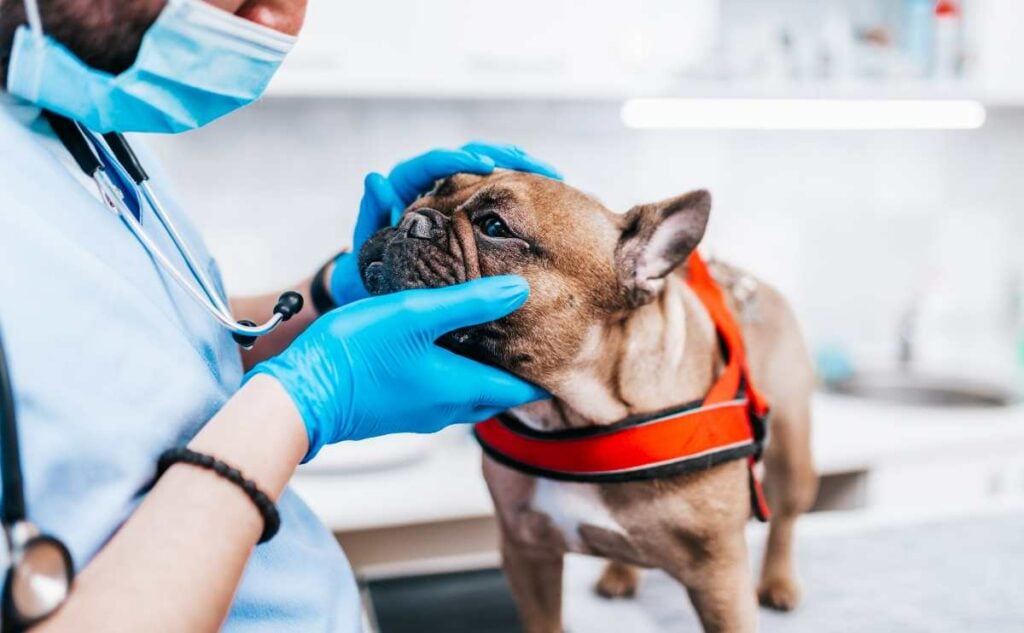
Want to learn more? Check out our dog goggles guide, where we review protective eyewear for pups of all shapes and sizes.
Our Personal Experience With Dog’s Night Vision
A few members of our Canine Journal team shared how night vision impacts their dogs’ daily activities.
Chips, The Cautious Night Walker
I take my pup, Chips, out twice a day, once in the daylight and once at night. Her behavior is noticeably different depending on when we go. During the day, she’s confident and relaxed. She walks with an easy gait, doesn’t pay much attention to strangers, and doesn’t bark at anyone. It’s like she knows the world is hers to explore, and nothing fazes her.
But at night, it’s a different story. Once the sun sets, she becomes more cautious. She stiffens up when we pass people, especially men or anyone wearing a hat. If someone gets too close, she can’t help but let out a bark, a warning that wasn’t there hours earlier.
I brought it up at our annual vet visit, wondering if maybe she wasn’t seeing well in the dark. The vet checked her eyes and reassured me that everything looked fine. Even with their superior night vision, they still don’t see as clearly in low light. Instead, they become more alert, relying on their other senses more, like smell and hearing, to make sense of their surroundings. That heightened awareness could make her more reactive to things that seem perfectly normal during the day.
So, while nothing is wrong with her eyesight, her nighttime behavior likely comes down to instinct. She’s more on guard with lower visibility, scanning for anything out of place. Maybe to her, a shadowy figure with a hat moving toward us is just a little too suspicious to ignore.
– Emma Braby, Rescue Dog Mom, Canine Journal Research & Writing
Another team member shares how her dog’s aging has started to impact her vision, especially at night.
Daisy’s Twilight
Daisy, come on, girl,” I say, giving the leash a gentle tug. But instead of her usual confident trot, Daisy, my senior Pitbull mix, moves slowly, her steps careful and uncertain.
At first, I brush it off. Maybe she’s just tired. But over the next few weeks, more changes appear. When the sun dips below the horizon, Daisy grows restless, pacing in circles before settling down, only to get up again minutes later. She no longer charges after her favorite ball in the yard; instead, she sniffs for it, nudging the ground as if searching for something invisible. Inside the house, she bumps into furniture she’s known her whole life, stopping in doorways like she’s forgotten where they lead.
One night, I called her for dinner. Instead of racing to her bowl, she stands frozen in the hallway. Her ears perked but unmoving. She tilts her head, listening, then cautiously steps forward, hugging the wall like she’s afraid of what she can’t see. Then, she stops again, staring at nothing. That’s when it hits me. Daisy isn’t just being cautious. She’s confused. She’s scared.
The vet confirms my suspicions. “She’s developing night blindness,” she explains, “but there’s more to it than that. The pacing, the disorientation, it’s dementia.” I swallow hard. I knew she was aging, but this feels different. More than just getting old.
After that, I adjust to her new needs. I leave nightlights on around the house, making sure a soft glow always guides her. I move furniture as little as possible. Our evening walks are slower, and I use my voice more, reassuring her with steady words.
At first, Daisy is frustrated. She whimpers when she gets lost in familiar rooms, her tail drooping when she bumps into walls. Some nights, she paces for hours, lost in a familiar place she no longer fully understands. But over time, she adapts. She learns to follow the sound of my footsteps and the rhythm of my breathing. Instead of chasing her ball, she waits for me to roll it close so she can find it by scent. She may not be able to see as well as before, but I will do anything to make her feel safe. As long as she trusts me, I will make sure she never feels lost.
– Danielle DeGroot, Rescue Dog Mom, Canine Journal Research & Writing
Night Blindness In Dogs: Causes And Signs
Night blindness, or nyctalopia, is a condition where a dog struggles to see in low-light or dark environments. It can develop gradually with age or result from underlying health issues affecting the eyes. While some dogs are naturally better at seeing in dim light, others may experience vision loss at night due to conditions like progressive retinal atrophy (PRA), cataracts, or glaucoma. Certain breeds, including Labrador Retrievers, Poodles, and Dachshunds, are more prone to inherited retinal diseases that lead to night blindness.
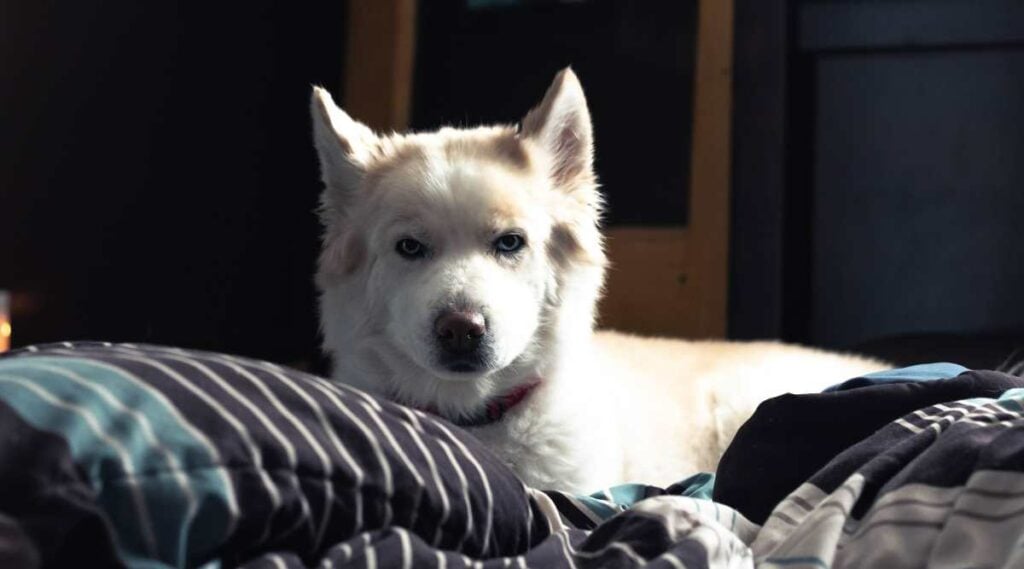
Signs of night blindness can include hesitation in dark rooms, bumping into furniture at night, increased anxiety in dim lighting, or reluctance to go outside in the evening. If your dog suddenly seems disoriented in the dark, a veterinary exam is crucial to rule out progressive eye diseases. While some cases of night blindness can’t be cured, making minor adjustments, such as adding nightlights, keeping pathways clear, and using contrasting surfaces, can help your dog navigate safely and stay confident in low-light conditions.
Helping Your Dog See Better As They Age
You can’t turn back the clock, but you can make small adjustments to help your senior dog feel safer, more confident, and less disoriented as their vision changes. Simple modifications to their environment and daily routine can make a big difference in keeping them comfortable.
Keep Lighting Consistent
Aging eyes take longer to adjust between light and dark spaces, making moving from a bright room into a dim hallway or a nighttime backyard trip more stressful.
- Place nightlights in areas where your dog frequently walks, like hallways, near food and water bowls, and beside their bed.
- If they sleep in a crate or a separate room, a soft lamp or plug-in nightlight can prevent them from waking up confused or anxious in the dark.
- Keep blinds partially open at night to allow some natural light to filter in, especially if they wake up and wander around.
Avoid Rearranging Furniture
Once a dog memorizes the layout of a room, their muscle memory helps them navigate even when vision declines. Moving furniture, pet beds, or water bowls can cause them to bump into things, hesitate, or feel uncertain.
- If changes are necessary, introduce them gradually and guide your dog through the new layout with verbal cues or gentle leash walks inside the home.
- Keep pathways clutter-free to avoid tripping hazards.
- Mark key locations with scented mats or rugs to help them orient themselves.
Use Contrast to Help With Depth Perception
As vision fades, depth perception becomes harder, making stairs, curbs, and even food bowls more difficult to see.
- A dark rug on a light-colored floor (or vice versa) can help your dog distinguish different surfaces.
- Placing a non-slip mat at the base of the stairs gives them a visual and tactile marker of where steps begin.
- Raised food and water bowls can make it easier for them to locate their meals, especially if they struggle with depth.
How Diet Impacts Your Dog’s Vision and Eye Health
What your dog eats doesn’t just fuel their energy. It plays a big role in keeping their eyes healthy, especially as they age. A diet rich in key vitamins and antioxidants can help protect against vision loss, cataracts, and retinal degeneration. While genetics and age play a role in eye health, proper nutrition supports long-term visual function and may slow down deterioration.

Best Foods for Eye Health
Adding the right nutrients to your dog’s diet can support their vision and help maintain strong, healthy eyes. Some of the best eye-boosting foods include:
- Blueberries & Cranberries – Blueberries and cranberries are packed with antioxidants that help fight oxidative stress and protect the retina from damage.
- Carrots & Sweet Potatoes – Carrots and sweet potatoes are loaded with beta-carotene, which the body converts into vitamin A, essential for good vision.
- Leafy Greens (Spinach, Kale, Broccoli) – Rich in lutein and zeaxanthin, two antioxidants that support eye function and may reduce the risk of cataracts.
- Pumpkin – High in vitamin A and zinc, which contribute to overall eye health and immune support. Pumpkin is also great for digestive health.
- Eggs – Eggs are a great source of lutein, zeaxanthin, and amino acids that support retinal health.
- Salmon, Sardines, & Flaxseed – These are loaded with omega-3 fatty acids, which help reduce inflammation and support overall eye function.
Choose high-quality dog food that includes real meat, vegetables, and essential vitamins rather than fillers and artificial ingredients. Incorporate fresh, whole foods like carrots, blueberries, and eggs into their meals as healthy treats.
Talk to your vet about vision-supporting supplements, especially for senior dogs or breeds prone to eye conditions. Many supplements include lutein, vitamin C, and DHA for extra eye protection. While food alone won’t guarantee perfect eyesight, a balanced diet with the right nutrients can help protect your dog’s vision for years to come. Healthy eyes start from the inside out!
Schedule Regular Vet Checkups
Many age-related eye conditions progress slowly, so you might not notice a problem until your dog is struggling. A vet can catch early signs of cataracts, glaucoma, or retinal diseases before they cause significant discomfort. Make annual eye exams a priority, and if your vet notices any developing issues, they may recommend eye drops, medications, or dietary changes to slow progression.
If your dog suddenly starts bumping into things, hesitating in dim light, or showing signs of eye discomfort (squinting, excessive tearing, or redness), schedule a vet visit immediately.
Consider Pet Insurance
Pet insurance can help you care for your dog as they age and develop different medical issues, like declining eye health. Learn more about what pet insurance is and what it covers in our Is Pet Insurance Worth It? guide.
Are Dogs Color Blind?
Dogs aren’t entirely color-blind, but they don’t see the world as we do. While humans have three types of cone cells in their eyes that allow us to see a full spectrum of colors, dogs only have two. This means their color vision is more limited, similar to a person with red-green color blindness.

Instead of vibrant reds and greens, dogs see muted shades of blue and yellow, while reds and greens appear as various shades of gray or brown. So, while they won’t appreciate a bright red toy the way you do, they can still distinguish colors, just in a different way.
This difference in color perception isn’t a disadvantage for dogs. Their vision evolved for survival, prioritizing motion detection and night vision over color detail. Since they rely more on movement, contrast, and their powerful sense of smell, seeing a full range of colors isn’t necessary. If you want to choose toys or training tools that stand out to your dog, go for blue or yellow, as these colors will be the most distinct in their world. We cover the subject of canine color blindness and share examples of what your dog sees in this in-depth guide.
How Do Dogs Compare To Cats in the Dark?
If you think your dog’s night vision is impressive, wait until you hear about their feline counterparts. Dogs may be better at seeing in low light than humans, but compared to cats, they’re basically fumbling around in the dark.
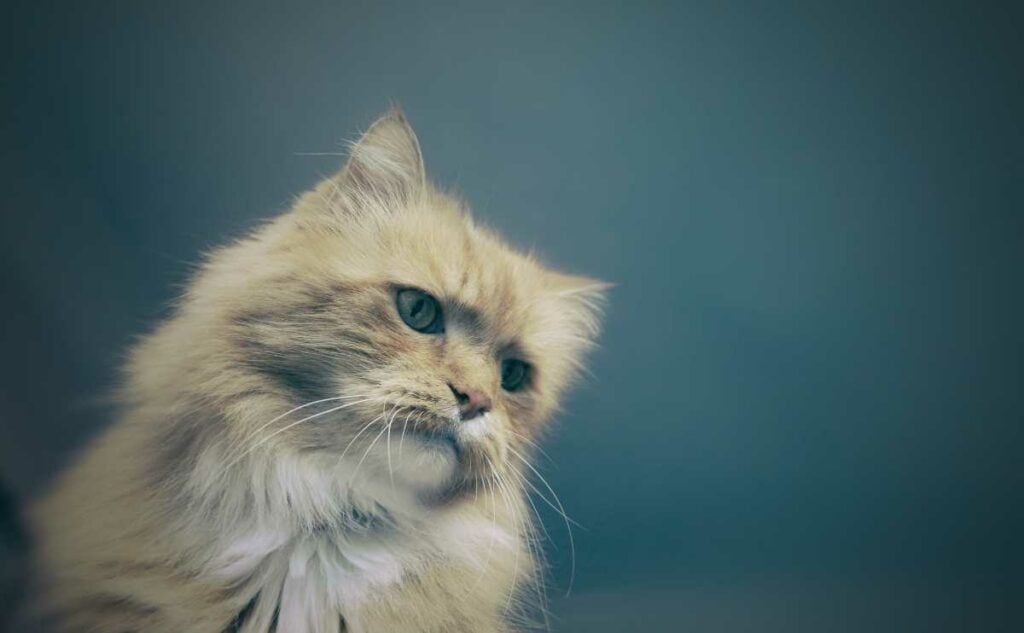
Why Are Cats Superior Night Hunters?
Cats were built for the night. Unlike dogs, which evolved as crepuscular hunters (active at dawn and dusk), cats are true nocturnal predators. Their ancestors hunted small rodents under the cover of darkness, using a combination of stealth, speed, and, most importantly, exceptional vision. Here’s why a cat’s eyes put both humans and dogs to shame in the dark:
Six times more rod cells – Cats have far more rod cells in their retinas than humans and about twice as many as dogs. Rod cells are responsible for detecting light, movement, and shapes in dim conditions. This means a cat can spot a scurrying mouse with laser precision while a dog might only catch a blur.
More prominent pupils mean better dilation. Have you ever seen a cat’s pupils go from tiny slits to enormous saucers? Their pupils expand far more than a dog’s, letting in as much light as possible, which helps them navigate and hunt with ease in near-total darkness.
A tapetum lucidum on steroids means better night vision. While both cats and dogs have a tapetum lucidum (the reflective layer behind the retina that bounces light back through the eye), a cat’s is far more efficient. This makes their eyes shine even brighter in the dark, and further amplifies their night vision.
Essentially, if a dog sees the world in grainy night vision mode, a cat sees it in high-definition low-light mode, and they’re ready to pounce on anything that moves.
What Do Dogs vs Cats See in the Dark? (Video)
Want to see how dogs and cats compare in a real-world test? BBC Two put their vision to the test in an experiment led by Rick Sanchez, a senior scientist at the Royal Veterinary College. The results are pretty fascinating! Check out the video here:
Other Animals With Incredible Night Vision
Dogs and cats aren’t the only ones who rule the night. Many animals have evolved specialized eyes that help them thrive in darkness, whether for hunting, avoiding predators, or navigating their environment.
Owls: The Ultimate Nighttime Predators
Owls take night vision to a whole new level. Their huge eyes take up almost half of their skull, allowing them to gather more light than nearly any other animal. They also have forward-facing eyes, which provide binocular vision for pinpointing prey. While dogs and cats rely on their whiskers or sense of smell when visibility is poor, owls simply turn their heads 270 degrees to scan their surroundings like a security camera.
Foxes: The Canine Night Hunters
Unlike domestic dogs, wild foxes are highly adapted for night hunting. Their eyes have vertically slit pupils, much like cats, which allow them to control the amount of light entering their eyes. This helps them stalk prey with precision in the dark. Their sharp hearing also helps them detect the slightest rustle of movement under leaves or snow. In fact, the Arctic fox is so good at detecting movement that it can hear small animals tunneling beneath the snow and dive in headfirst to catch them.
Geckos: The Unexpected Night Vision Champs
You might not think of reptiles as having impressive eyesight, but some geckos have night vision that’s 350 times more powerful than a human’s. Instead of rod and cone cells like mammals, geckos have multi-focal eyes that allow them to see color in complete darkness. Imagine having built-in night-vision goggles that also let you see in full color. Geckos basically have that superpower.
So, Where Do Dogs Rank?
Compared to humans, dogs see the night much more clearly. Compared to cats? Not even close. Compared to an owl or a gecko? They might as well be wearing sunglasses at midnight. Still, your dog doesn’t need perfect night vision to thrive. Their incredible sense of smell and hearing make up for what their eyes lack. Even if they can’t see a lurking squirrel in the shadows, they can smell where it’s been, hear it rustling in the trees, and probably still bark at it for good measure.
So, while dogs may not be the kings of the night, they hold their own in the low-light Olympics. And let’s be honest, if they could fly silently like an owl or stalk prey like a fox, we’d all be in trouble. Does your dog have exceptional night vision or trouble seeing at night? Share your stories with us in the comments.
Keep Your Pup Visible Night
If you enjoy nighttime walks with your dog, making sure they’re visible is just as important as keeping them leashed. Low visibility can be risky, especially near roads or bike paths, where drivers and cyclists may not see your pup. Even in well-lit areas, shadows can make dogs blend into their surroundings, increasing the chance of accidents.
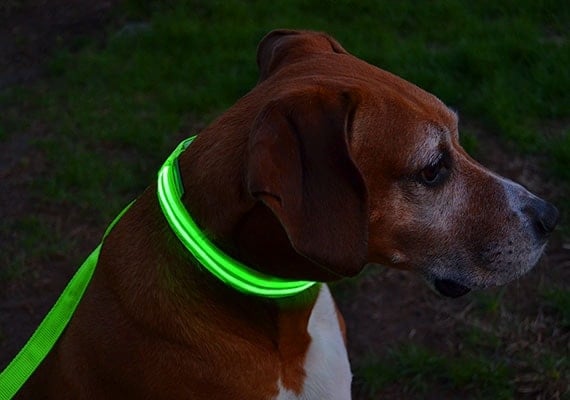
A light-up collar or harness, reflective leash, or clip-on LED light can make a huge difference in keeping your dog noticeable in the dark. And you can always add light-up charms to your shoes. For extra safety, stick to well-lit paths and wear reflective clothing or carry a flashlight so you’re visible, too. A shorter leash helps keep your dog close, preventing them from suddenly darting into traffic. Always stay alert. Dogs can get startled by noises in the dark, so keeping control and being prepared will make your evening walks safer and more enjoyable.
Why Trust Canine Journal?
Sally has over 20 years of experience in human health sciences communications, including more than 10 years as an expert on pet health conditions and treatment. She’s part of a team of dedicated canine professionals and long-time dog owners at Canine Journal. We test and research the best pet products, not only for our own pups but for all of our readers.

